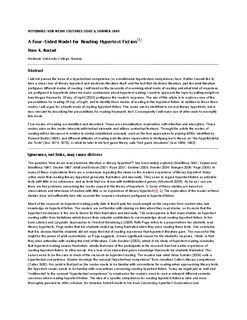A four-sided model for reading hypertext fiction
Journal article, Peer reviewed
Permanent lenke
http://hdl.handle.net/11250/134294Utgivelsesdato
2009Metadata
Vis full innførselSamlinger
Originalversjon
Rustad, H. K. (2009). A four-sided model for reading hypertext fiction. Hyperrhiz: The New Media Culture, 6(1), 1-17.Sammendrag
I will not pursue the issue of a hypertextual competence (or a multimodal hypertextual competence) here. Rather I would like to
take a closer look at literary hypertext and electronic literature itself, and the fact that electronic literature, just like print literature,
prefigures different modes of reading. I will insist on the necessity of examining what mode of reading and what kind of responses
are prefigured in hypertexts when we make conclusions about hypertext reading. I want to approach the topic by putting weight on
how Megan Heyward’s Of day, of night (2002) prefigures the reader's response. The aim of this article is to explore some of the
preconditions for reading Of day, of night, and to identify three modes of reading in this hypertext fiction. In addition to these three
modes I will argue for a fourth mode of reading hypertext fiction. This mode can be identified in several literary hypertexts, but is
less relevant for describing the preconditions for reading Heyward's text. Consequently I will make use of other work to exemplify
this mode.
Four modes of reading are identified and described. These are semantization, exploration, self-reflection and absorption. These
modes arise as the reader interacts with textual elements and utilises contextual features. Through the article the modes of
reading will be discussed in relation to similar established concepts, such as the four approaches to playing MUDs identified by
Richard Bartle (1996), and different attitudes of reading print literature represented in Wolfgang Iser's theory on "die Appellstruktur
der Texte" (Iser 1974, 1978), or what he later in his text game theory calls "text game structures" (Iser 1989; 1993).
Beskrivelse
Link to the original published article: http://www.hyperrhiz.net/hyperrhiz06/19-essays/80-a-four-sided-model
